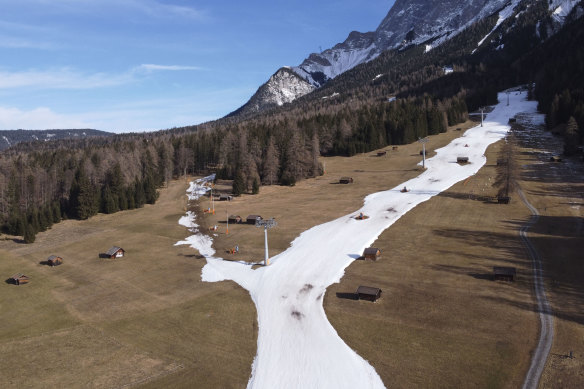This was published 1 year ago
Opinion
Your next ski holiday could end up being a waste of money
Ben Groundwater
Travel writerThey were dreaming of a white Christmas at Whistler Blackcomb – but they didn’t get it.
You would think at a ski resort, probably Canada’s most famous, a good blanket of snow on Christmas Day would be assured, but that’s not the way things panned out in 2023. Any ski bums checking out the Whistler snow cams on December 25 would have been presented with a pretty bleak sight: the base of the mountain, at the bottom of the main chair lifts, was nothing but grass and concrete, with just a dusting of snow visible further up the mountain.

Zugspitze in Austria in January last year, where unseasonably warm weather led to a lack of snow at the country’s ski resorts.Credit: Getty Images
It was a rough start to the season in this part of British Columbia. Whistler picked up 99 centimetres of snow in November last year – that’s the lowest since 2004. In December it had 169 centimetres, though the only snow that survived until Christmas was up towards the top of the mountain.
At nearby Grouse Mountain ski resort, meanwhile, the company reopened summer activities such as zip lines and ropes courses in December to keep staff and visitors amused, given the lack of snow.
Whistler eventually got its hit of the good stuff, a dump of more than 60 centimetres in a day in early January. That was probably enough for passionate ski fans to put the horror start to the season to the back of their mind, an anomaly best forgotten.
But it shouldn’t be forgotten, because this anomaly is likely to become the norm. Global temperatures are rising, and ski resorts are feeling the heat.
Over in the European Alps, ski seasons are becoming markedly shorter as temperatures rise and rainfall – rather than snowfall – increases. In the US, the ski season shrunk by 34 days at some resorts in the period from 1982 to 2016. Snow cover in Australia, meanwhile, is forecast to decrease by up to 93 per cent by the year 2050.
Obviously, you wouldn’t be investing in a ski resort right now, particularly not one at low altitude – that is, a resort at lower than 1500 metres above sea level, which is going to be the hardest hit by changes in global temperatures in the next few decades.
Most of us don’t have that on our radars though. What we do have is a ski holiday. And even that is becoming increasingly risky.
If you’ve been skiing or snowboarding long enough, then you would be familiar with the perils of relying on the weather for a great holiday. All of us have had a dud ski trip at some point in our lives – this isn’t a new phenomenon.
I went to Thredbo back in the mid-2000s in June – touch-and-go even in a good season –and it was pure grass all the way up to the mid-stations. I went snowboarding in Austria in March about seven or eight years ago, at a time when the snow should have been good, and instead got rained on for four days straight.
But these incidents are likely to become far more common in coming years. And herein lies the risk.
Ski trips are expensive, particularly if you’re forking out for a northern hemisphere holiday. We’re talking tens of thousands of dollars in most cases. You also have to take leave from your job, which is a finite resource that needs to be spent wisely.
And then, what? You arrive and find you’re going zip-lining for the next five days instead of taking powder shots in the backcountry?
This is the future for skiers and snowboarders. The primary risk to consider now is not ACL tears and broken collarbones and how you’ll manage with your life back home if you wrap yourself around a tree.
The primary risk to consider when booking a ski trip is that you won’t be going skiing or snowboarding at all, because the snow cover will be so bad. Or perhaps you will be able to hit the slopes, but all that money of yours has been spent on riding icy, man-made groomers in the mornings and vast acres of slush in the afternoon.
These new conditions are also going to make peak periods at ski resorts even busier, with fewer visitors keen to roll the dice on early- or late-season holidays. That means longer lift lines, longer food queues, higher prices.
All of this makes a ski trip harder to justify, and for a lot of us, a ski trip was already hard to justify.
I feel for those in the industry, because this is one of the great holidays, and those who work at ski resorts are generally great people who are there to provide a fun time. I also love a ski trip as much as the next powderhound, and have done since I was a kid.
But the world is changing, and in the future perhaps a trip to a mountainous region for the likes of biking, hiking or even zip-lining is going to seem like a much safer bet.
Sign up for the Traveller newsletter
The latest travel news, tips and inspiration delivered to your inbox. Sign up now.